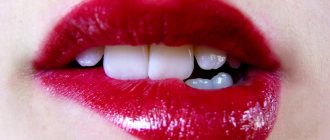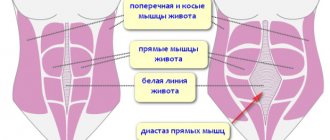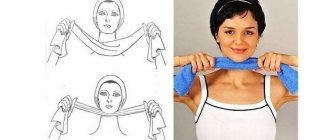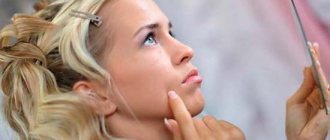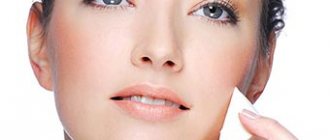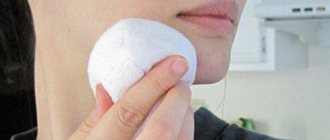Inheritance or acquisition?
Prominent ears are an overgrowth of the cartilage tissue of the auricle or a violation of the angle of attachment of the cartilage, that is, an anatomical feature. Most often it is a family “trait”. True, there is also a version that protruding ears are formed due to incorrect presentation of the fetus during pregnancy. But it is controversial, many experts disagree with it.
Some parents believe that slight protruding ears can be corrected at an early age by “gluing” the ears to the head with a medical plaster at night... A naive misconception! And unsafe: the patch can cause deformation of the auricle and inflammatory processes on the skin. Without otoplasty - plastic surgery - correction is impossible.
Is it possible to get rid of protruding ears without surgery? Contraindications to otoplasty
It is possible to get rid of protruding ears without surgical intervention only during the period of continued formation of the auricle, which occurs in infancy, usually up to one year.
At this moment, it is possible to tightly fix the growing and developing ear in a special silicone form, which will give the ear the necessary relief in the future. Unfortunately, at a later age, changing the shape of the auricle without invasive intervention is almost impossible.
Contraindications for ear surgery are the same as for any operation, with the exception of some features and additions.
- The patient's age is up to 6 years.
- Any disease that occurs in an acute form, or chronic - during an exacerbation period.
- Menstruation and pregnancy.
- Any form of diabetes.
- Thyroid disorders.
- Neoplasms of malignant origin.
- Blood clotting disorders. People taking aspirin or any anticoagulant medications should stop taking them at least two weeks before surgery.
Scalpel and laser
The operation goes like this: a small incision is made from the “underside” of the ear so that there are no visible traces left later. The cartilage is released and trimmed. The operation is performed either with a conventional scalpel or with a laser. The laser allows you to act more accurately and precisely. Another advantage over a traditional scalpel is that the laser beam, cutting the tissue, immediately “seals” the blood vessels, so there is practically no blood loss. The cartilage is fixed in a new place, cosmetic sutures are applied to the skin, and self-absorbable surgical sutures are used. The surface of the wound is treated with special antiseptic ointments and a sterile bandage is applied, and on top is a compression tape, similar to the one worn by tennis players on the court. The operation lasts on average about an hour.
Young patients are given general anesthesia, while adolescents undergo the operation under local anesthesia.
Important
How to prepare for otoplasty?
Before the operation you must do:
>> Clinical blood test with determination of platelet count and clotting time. >> Biochemical blood test. >> Blood test for infections (hepatitis A, C virus, etc.). >> General urine test. >> Electrocardiogram.
And:
>> Consult your pediatrician. >> Bring your baby to surgery on an empty stomach.
Point of view
Pro & contra
Marina, mother of 4-year-old Nadya:
– My daughter got my ears: they don’t puff up very much, but we will definitely operate! I suffer terribly because of this defect: I’ve worn the same hairstyle all my life, I’m afraid of the wind accidentally exposing my ears, I can’t wear earrings. But, unfortunately, I can’t have surgery due to my health. But my daughter has no contraindications, I can’t wait until she grows up to the correction, I don’t want to condemn her to the same problems.
Tatiana, mother of 8-year-old Dima:
– My son is teased at school because of his protruding ears. The boy is ready to do anything to get rid of this shortcoming. But my husband is categorically against otoplasty. I don’t know how to convince him yet.
Oleg, father of 7-year-old Igor:
– Prominent ears are not a vice or a defect. She never bothered me in my life, although the guys tried to tease me at school. But I responded with ridicule and sometimes with fists. Nothing, they even respected me. Our son is still worried about his ears, but we are not even thinking about surgery. Let him learn to resist offenders!
A baby’s ears stick out: how to fix a child’s protruding ears without surgery?
Many children have protruding ears after birth, and this phenomenon does not bother parents. But as a child grows up, he or she may experience complexes regarding a cosmetic defect.
To avoid such discomfort, you can try to correct this situation in different ways.
First, let's figure out why a baby's ears sometimes stick out: this is due to the formation of the ear cartilage at a right angle to the temporal bone.
Causes of protruding ears
Prominent ears in newborns are caused by hereditary factors or intrauterine pathologies. The main causes of protruding ears include:
- vascular abnormalities in infants (as a result of which the external auditory organ is not supplied with oxygen and lags behind in development);
- macrotia is an intrauterine pathology accompanied by excessively rapid growth of the ear due to deformation of the facial skeleton of the unborn child);
- shell hypertrophy in infants;
- underdevelopment of the baby's ear (not only the protrusion of the organ may be noticeable, but also its different sizes relative to each other).
Note! Prominent ears (ears stick out) in infants can be caused by several reasons simultaneously. If the condition of the ears may cause psychological discomfort to the child in the future, it is better to correct the problem at an early age.
Stages of childhood protruding ears
Before you begin to correct protruding ears in a baby, you need to understand the complexity of the pathology.
Congenital protruding ears in newborns is considered a hereditary factor
- The first degree of the disease in infants is characterized by slight protrusion of the ear from the facial skeleton. Approximately the deflection angle is 45 degrees. Usually this defect does not require correction, and the problem is solved by choosing the right hairstyle.
- The second degree of protruding ears is diagnosed if the angle exceeds 45 and reaches 90 degrees. Here, laser otoplasty is recommended, followed by restorative procedures for the infant.
- The third degree exceeds 90 degrees between the head and the auricle. In this situation, excess cartilage tissue is removed and a shell curl is artificially created.
Diagnosis of protruding ears
Parents can determine that a newborn’s ear is protruding on their own; an ENT specialist will only confirm the phenomenon and prescribe treatment in a conservative and aesthetic way before prescribing surgical intervention.
Children say! In the corridor of the clinic, a boy (about 3 years old) takes out his backpack and says that he has a cucumber, a banana, and a tomato with him. “What a thrifty guy, he won’t die of hunger,” the adults praise him. And then they start giggling: the child takes out green, yellow and red cars...
How to correct protruding ears: effective methods
Until a child reaches 6 years of age, interventions to change the size of the auricle are prohibited. This is explained by the fact that children's ears complete their formation at 6-7 years of age. Therefore, you can try to get rid of the problem with special devices.
- OtoPlastic correctors are designed for everyday use by infants. They are used at an early age, while the ears are still very soft and can be corrected. Approximate wearing period is 3-4 months.
- Use of improvised means. At home, you can put caps, scarves, special headbands, and elastic bandages on your baby to correct protruding ears.
- Otoplasty or surgery. This correction method is allowed only after six years, since there is a chance that the normal shape of the auricle will be restored.
In healthy babies without hereditary pathologies, the ears are always pressed to the facial skeleton
Note! If the ears stick out or roll up in children who have not yet reached the age of one, do not rush to undergo otoplasty! There is a risk of damaging the nerve endings in the ear. In the future, this may affect the perception of low-frequency sounds.
Types of ear correctors for children
For newborns and infants, ear correctors are approved for use. You can choose suitable products for eliminating protruding ears from our rating.
- Devices from the OTOPLASTIC brand are intended for one-time use for 1-2 days if the ears stick out too much.
After which the corrector is replaced with another. The package contains 36 copies, which is enough for the first course of treatment for an infant’s protruding ears. Such items are produced in Dubai. Approximate price 4 thousand rubles. Ear correctors for babies will correct protruding ears in a few months - Mairs correctors for babies are a sticker on the ear. When worn, the item does not interfere, is practically not felt, and does not cause discomfort to the baby. Children are prescribed a three-month course of ear restoration. Produced in Russia, 8 pcs per pack. Approximate cost: 1000-1300 rubles.
- Arilis ear correctors for infants can be used for children from the first month of life. They correct protruding ears non-surgically. The package contains from 4 to 10 pieces. Price from 890 to 1700 rubles.
- Otostik Baby. Correctors for ears in infancy. Prescribed from the first days of life. The set contains 8 correctors. Wearing one pair is prescribed for a seven-day period. Manufacturer Spain, estimated cost 2 thousand rubles.
We recommend watching a video where experts talk about the possibilities of doing without surgery.
How to put on an ear corrector for a child: important tips
The basis of children's ear correctors is a special hypoallergenic glue. When fixing devices to a baby’s ear that is protruding, you need to follow the following recommendations:
- choose the desired and most convenient area of the skin where the corrector will be attached (it is not recommended to change the location in the future);
- degrease the area using regular alcohol;
- keep the skin behind the baby's ear clean (there should be no hair or moisture);
- it is necessary to stick the corrector only in a dry room (since at high humidity the structure of the adhesive base changes);
- Do not allow a fold to form under the sticker (this will lead to injury to the delicate skin and the development of diaper rash).
Instead of ear correctors, you can use improvised means: patches or bandages
Surgery (otoplasty)
Otoplasty is resorted to if wearing correctors in infants is unsuccessful. They begin with preparation for surgery. For this, the patient is fully examined: all tests are collected, X-rays and fluorography are taken.
Shortly before medical correction, when the ear is protruding, all medications taken by the child should be discontinued. It is imperative to inform the attending physician about what medicine is prescribed to the patient and why. After summing up the results of a full examination, the baby is given general anesthesia (it is preliminary assessed how his body will tolerate anesthesia).
Children say! Nika was asked to wash the dishes. She stood at the sink, turned on the water, put a fork under it and stood looking dejected. - Nika, what are you worth? - I’m not standing, I’m doing two things at once! - I wonder which ones? Thoughtfully, but confidently: - I wash the dishes and... stick
.
An incision is made from the back of the baby's protruding ear (see photo), the excess part of the cartilage is removed, after which sutures are applied. The operation can be performed using a laser. This method causes virtually no complications, since it has a destructive effect on the cartilage of the ear tissue.
Otoplasty is an indication if the auricle does not recover by the age of 6 years.
Contraindications to otoplasty in children
Surgical intervention for infants to correct protruding ears is prohibited for:
- acute respiratory diseases;
- otitis media of eustacheitachase form;
- infectious diseases (chickenpox, rubella, mumps);
- chronic diseases (tuberculosis, diabetes, etc.).
How is otoplasty performed to remove excess ear cartilage?
Rehabilitation of a child after surgery
Rehabilitation after surgery requires 20-40 days. During the first week after otoplasty, the baby must wear special cushions that support his ear in the correct position so that the cartilage tissues grow together successfully. Also recommended:
- wearing an elastic sterile bandage;
- lack of physical activity and emotional stress;
- visiting swimming pools and baths is prohibited (as there is a risk of infection in unhealed wounds);
- undergo physical procedures in a timely manner.
Complications of surgery
In rare cases, consequences occur in infants in the form of pain, increased temperature, and poor formation of the auricle in newborns. Swelling of the parotid tissues and inflammation occurs.
Ear correctors for newborns are securely attached and do not interfere with the baby
If restoration measures are not followed, the ears may detach, and they begin to stick out again, and rough scars form. You must tell your pediatrician about any problems. If defects are detected, additional postoperative treatment is prescribed.
How to prevent protruding ears in infants?
To prevent a baby's ears from sticking out after birth, there are no special preventive measures. In most cases, this feature depends on heredity. As general recommendations, women can be advised to plan their pregnancy and undergo all gynecological appointments and ultrasound examinations in a timely manner.
How does otopslasticity occur? We recommend watching the video:
Source: https://dearmummy.ru/pochemu-torchat-ushki-u-grudnichka-vrozhdennaya-i-priobretennaya-lopouxost.html
Expert commentary
Psychologist Olga Vladimirova:
– Should I correct protruding ears or not? In my opinion, this is a very personal question, and not of the parents, but of the child himself. You cannot categorically impose your position on him. Even if protruding ears caused a lot of problems for a mother, this does not mean that her daughter will have the same problem. If a child is teased by his peers, yes, this can become a psychological problem for him. But try to understand its origins: perhaps protruding ears are only a momentary reason: peers simply see how sharply their friend reacts to teasing, so they pester him. Try to teach your child to respond to ridicule with a smile or a joke. Explain that the offenders will simply not be interested in “getting” him.
Reflections about one's own appearance usually begin in children during adolescence, and not at 6–7 years old. If this happened earlier, it is important to find out in a confidential conversation what exactly is bothering the child. And if it turns out that he is really worried precisely because of his protruding ears, then, of course, this defect needs to be corrected. It's hard to convince your dad, can't find any compelling arguments?
Consult a psychologist, tell us about the situation in the family, the character of your husband - a solution will probably be found.
Causes of development of protruding ears and its symptoms
By the seventh month of intrauterine development, the fetal ears acquire a normal shape, which remains the same at birth. The main increase in size occurs in the first years of a child’s life and by 3 years it is about 85% of the size of an adult, and by 7 years - 95%. The following criteria are considered ideal (aesthetically) ears for Caucasians:
- their deviation is 20-30° posterior from the ear axis, passing through the upper edge of the helix and the earlobe;
- total average length of the auricle (65 mm);
- lobe length (from 15 to 20 mm);
- the location of the lower pole of the earlobe is at the level of the base of the tip of the nose, and the upper point of the helix is at the level of the arch of the eyebrow;
- the distance between the edge of the ear and the skull is about 20 mm.
Abnormal ear position is the most common form of congenital ear abnormality. Its manifestations are caused by insufficient development of varying degrees of severity of the antihelix or its absence at all (microtia), and its legs, which hold the auricle at the required angle in relation to the lateral surface of the head. Excessive thickness and excessive elasticity of the cartilage, irregular shape of the helix and increased height of the ear cup also play a certain role.
The main signs of an aesthetic defect are:
- smoothness of the contour of the auricle;
- increasing the angle of contact with the head;
- smoothness of the antihelix or its absence.
Is protruding ears inherited?
The reasons for this aesthetic defect may be:
- Genetic predisposition is the most common reason. “Protruding” ears, as a rule, are bilateral, in rare cases - unilateral and occur in half of newborns with the same frequency in girls and boys. If one of the close family members or distant relatives had this defect, it is inherited and can appear both in the immediate and distant generations - even among children whose parents did not have this anomaly.
- Features of intrauterine development associated with the influence of unknown factors and accompanied by insufficient development of the antihelix and/or excessive growth of the cartilaginous structures of the ears.
- Much less often, “bulging” can occur as a result of birth or other traumatic injuries.
Depending on the angle between the skull and the auricle, there are 3 degrees of protruding ears:
- I degree - the angle is from 31 to 45°. With such a deviation, the defect is visually almost invisible.
- II degree - 46-90°.
- III degree - more than 90°. The aesthetic disadvantage in this case is pronounced.
